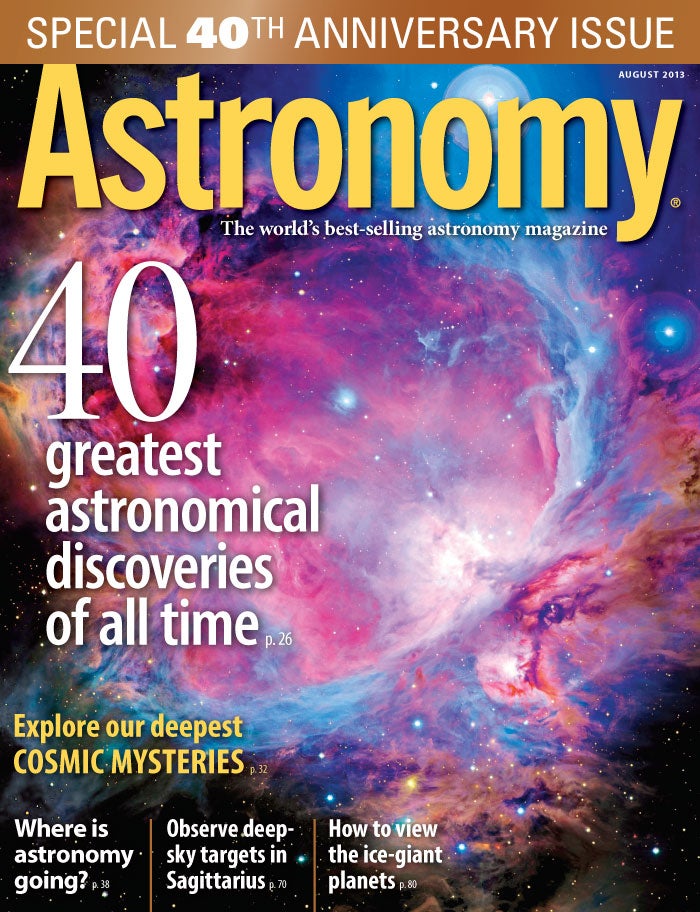
Waukesha, Wis. – First published in summer 1973, Astronomy magazine has seen many historic discoveries in its lifetime. The August issue of Astronomy examines the past 40 years of the science and hobby, travels into the next 40, and describes the biggest mysteries about the universe that scientists currently face. This special issue also gives the history of Astronomy magazine.
The August 2013 Astronomy magazine hits newsstands July 2.
From noting that Earth is a sphere, to the discovery of Neptune, to learning that the Milky Way is just one galaxy in a sea of others, scientists have uncovered a tremendous amount about the ever-growing universe. Senior Editor Richard Talcott describes these and 37 other important findings in “40 greatest astronomical discoveries.” Don’t expect a ranking system, however; Talcott instead describes the discoveries from near to far, because, as he writes, “A planetary scientist is bound to have a different perspective from a stellar astrophysicist, and neither likely would choose the same breakthrough as a cosmologist.”
“40 years of amateur astronomy”
Amateur astronomy has seen many changes in the past four decades, and Senior Editor Michael E. Bakich – who’s been involved in the hobby for more than that amount of time – outlines dozens of them in “40 years of amateur astronomy.” For example, did you know that the first written mention of a “Messier marathon” appeared in a 1980 issue of Astronomy magazine, and digital camera imaging by amateur astronomers began in 1985?
“40 greatest mysteries of the universe”
Even as astronomers discover how stars work and what our stellar neighborhood looks like, they continue to ask more questions and realize the universe remains full of mysteries. Scientists, for example, still don’t understand what the true nature of gravity is or what causes black hole jets. In “40 greatest mysteries of the universe,” Associate Editor Sarah Scoles describes the biggest questions that astronomers are currently researching.
“Hunt down summer’s best dark nebulae”
If you’re itching for a new observing experience, ignore the bright objects and instead aim for darkness. Senior Editor Michael E. Bakich will help guide you to two dozen of these dark nebulae. Such objects are “interstellar clouds that obscure the light coming from the stars or bright nebulae behind them,” explains Bakich, “and their shapes are among the strangest in the sky.”
August 2013 night-sky events visible without optical aid
- August 3 – The Moon stands near Jupiter and Mars in the east shortly before sunrise.
- August 9 – The Moon passes 5° south of Venus.
- August 12/13 – The Perseid meteor shower peaks under Moon-free skies before dawn.
- August 12 – The Moon stands between Saturn and the star Spica.
Also in the August 2013 Astronomy
- “Where will astronomy be in 40 years?” – The future of astronomy involves larger collaborations, greater computing power, and bigger telescopes.
- “Astronomy magazine’s path to ‘stardom'” – From its modest beginnings, the publication now leads the astronomy hobby as the most popular magazine of its kind in the world.
- “40 deep-sky targets in Sagittarius” – The Archer contains a dizzying variety of dazzling objects.
- “A backyard imager advances science” – An unexpected email opened the door for this astroimager to contribute to our understanding of the universe.
- “Prime time for Neptune and Uranus” – Late summer and early fall are the best times to track down the solar system’s distant planets.
- “The Sky this Month” – Exclusive star charts will guide you through the night sky.
- The August issue of Astronomy also includes Astro News, Ask Astro, Snapshot, Breakthrough, Bob Berman’s Strange Universe, Stephen James O’Meara’s Secret Sky, Glenn Chaple’s Observing Basics, Tony Hallas’ Cosmic Imaging, Cosmic World, Letters, Web Talk, New Products, Reader Gallery, and Final Frontier.









